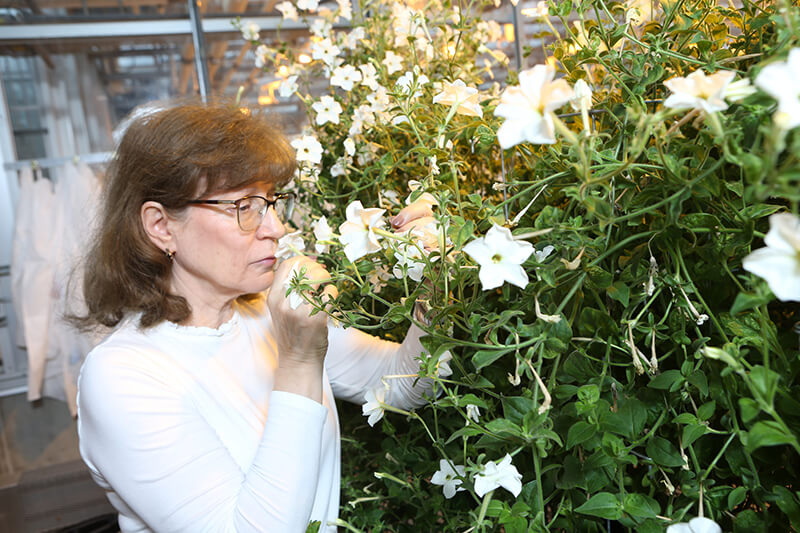Plant defense layer has unexpected effect on volatile compounds, study finds

A Purdue University biochemist and her colleagues have pioneered new methods for increasing production of volatile compounds important for plant defenses and for use in biofuels, pharmaceuticals and other products. While investigating how plants can more efficiently emit those compounds, Natalia Dudareva’s team also found an unanticipated factor playing a role in plant cellular functions.
Dudareva’s team had previously analyzed emission of volatile compounds through plasma membranes and was working on simplifying passage through the cuticle, a waxy substance on the surface of plant organs that is part of a plant’s defenses against pathogens and pests. The cuticle also helps plants retain water, and similarly can trap volatile compounds in tissues.
The solution, the team thought, would be to thin the cuticle. The lab did so by manually removing some of the cuticle from petunia flowers and developing genetically altered petunias that had thinner cuticles.
“If the cuticle serves as a barrier on the outside of a flower, logically you would think that a thinner cuticle would make it easier for plant volatile compounds to move through it,” said Dudareva, a distinguished professor of biochemistry and interim director of the Purdue Center for Plant Biology. “We saw the opposite, however. Thinning the cuticle led to decreased volatile compound emissions and even less production of these compounds in the plants overall.”
Prior to these findings, which were published in the journal Nature Chemical Biology, the cuticle wasn’t known to play any role in internal volatile metabolism. The team, which also included biochemistry postdoctoral researcher Pan Liao and chemical engineering graduate student Rick Ray, found that the key issue is that hydrophobic volatile compounds are attracted to accumulating in the hydrophobic cuticle, which prevents internal cellular buildup.
“When we made the cuticle thinner, we reduced the amount of volatile storage,” said Joseph Lynch, a research scientist in Dudareva’s lab. “With no place to go, producing the same amount of volatiles would have been toxic to the plant. The cells either had to reduce the production of volatiles or die.”
John Morgan, professor of chemical engineering, said the findings allowed the team to coin the term “volatile emission factor,” which is the ratio of the rate of volatile emitted to the rate of volatiles being synthesized in the plant. The parameter should be applicable to any plant volatile.
“We chemical engineers get excited about dimensionless numbers, and we had the opportunity to develop one here,” Morgan said. “We hope that people adopt this in their work.”
Going forward, Dudareva and her team will continue working on methods to increase emission of volatile compounds in plants, including investigating how thickening the cuticle might affect production and emissions.
“We learned that the cuticle is a sink, and if you don’t have that sink, the cells shut down production of those volatiles,” Dudareva said. “This makes increasing emissions more complicated than we once thought, but sheds light on factors that can affect production of these compounds.”
The National Science Foundation and the U.S. Department of Agriculture’s National Institute of Food and Agriculture funded this work.
Writer: Brian Wallheimer; 765-532-0233; bwallhei@purdue.edu
Sources: Natalia Dudareva; 765-494-1325; doudarev@purdue.edu
Joseph Lynch; 765-496-6268; lynch51@purdue.edu
John Morgan; 765- 494-4088; jamorgan@purdue.edu